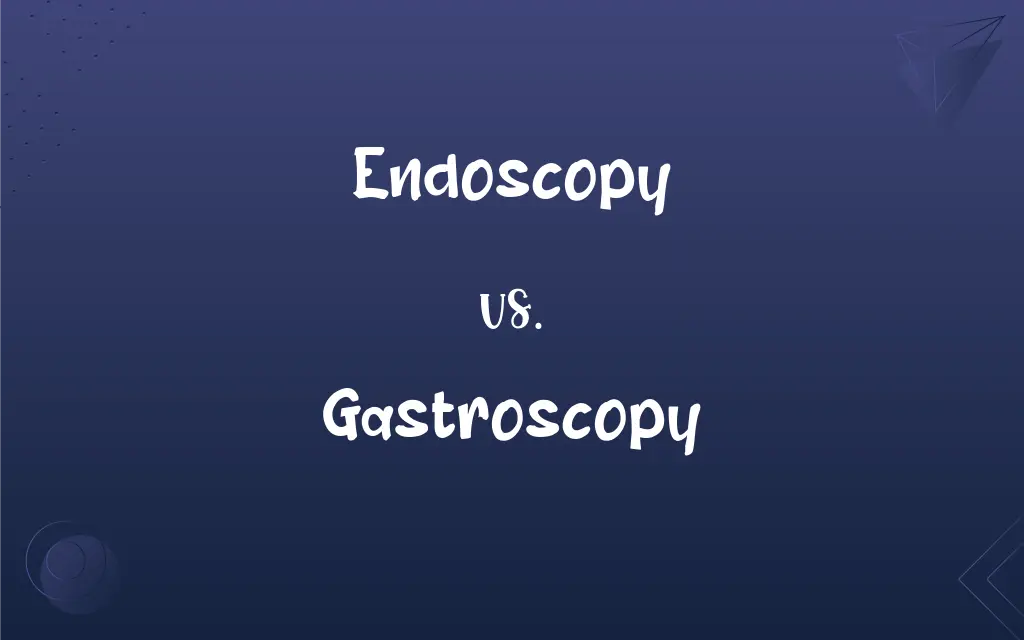Endoscopy vs. Gastroscopy: What's the Difference?
Edited by Aimie Carlson || By Harlon Moss || Updated on October 9, 2023
Endoscopy is a medical procedure using a flexible tube with a light and camera to view various internal parts of the body, while gastroscopy, a type of endoscopy, specifically examines the upper part of the gastrointestinal tract.

Key Differences
Endoscopy involves utilizing a specialized instrument, called an endoscope, to visualize internal structures of the body, including numerous areas like the esophagus, stomach, and colon. Gastroscopy, conversely, strictly focuses on inspecting the upper gastrointestinal tract, comprising the esophagus, stomach, and the initial part of the small intestine. The scope employed in a gastroscopy is referred to as a gastroscope.
The broad nature of endoscopy encapsulates various forms of internal examination, including both the upper and lower parts of the gastrointestinal tract, respiratory tract, and more, utilizing an endoscope. On the contrary, gastroscopy distinctly signifies a targeted procedure, where the exploration is deliberately restricted to upper digestive tract regions. Hence, all gastroscopies are endoscopies, but not all endoscopies are gastroscopies.
In endoscopy, the type of endoscope and the specific procedural name changes according to the body part being examined, such as colonoscopy for the colon, or bronchoscopy for the bronchi. Whereas, gastroscopy adheres to a singular, designated purpose, examining only specific upper digestive structures without variation in terminology or methodological application.
Endoscopy can be utilized for various diagnostic and therapeutic purposes across different bodily regions, offering a versatile investigative platform for medical practitioners. In contrast, gastroscopy provides a concentrated diagnostic window, prominently assisting in identifying issues within the upper gastrointestinal realm, like ulcers or tumors, maintaining its specialized purpose.
Through the flexibility of endoscopy, medical professionals can access, visualize, and sometimes treat conditions in multiple body regions, making it an invaluable tool in modern medicine. Gastroscopy, while limited to a specific region, presents its own indispensable value, offering detailed insight and facilitating interventions specifically within the upper digestive tract.
ADVERTISEMENT
Comparison Chart
Scope of Application
Applied to various body parts internally.
Strictly applied to the upper gastrointestinal tract.
Terminology
Different names for different body parts.
Always referred to as gastroscopy.
Purpose
Can be diagnostic or therapeutic.
Mainly diagnostic but can be therapeutic for upper GI.
Specialization
General term for internal visualization.
Specialized term for upper GI visualization.
Instruments Used
Various endoscopes based on body part.
Specifically uses a gastroscope.
ADVERTISEMENT
Endoscopy and Gastroscopy Definitions
Endoscopy
Endoscopy involves inserting a flexible tube with a light and camera into a body passage.
Through endoscopy, they were able to visualize the patient’s esophagus.
Gastroscopy
Gastroscopy is a procedure to visually examine the upper part of the gastrointestinal tract.
The gastroscopy revealed inflammation in the patient’s esophagus.
Endoscopy
Endoscopy enables visualization of internal organs without invasive surgery.
An endoscopy provided a clear view of the patient's stomach lining.
Gastroscopy
Gastroscopy utilizes a gastroscope to inspect the stomach and small intestine's initial part.
During the gastroscopy, biopsies were taken from the stomach lining.
Endoscopy
Endoscopy is a non-surgical procedure used to examine a person's digestive tract.
The doctor recommended an endoscopy to investigate the patient’s digestive issues.
Gastroscopy
Gastroscopy requires fasting and specific preparation to ensure clear visualization.
The patient adhered to a strict diet before undergoing the gastroscopy.
Endoscopy
Endoscopy encompasses various procedures like colonoscopy, bronchoscopy, etc.
The specialist decided to conduct an endoscopy to explore the patient’s colon.
Gastroscopy
Gastroscopy can be used to perform minor surgical procedures like removing polyps.
The surgeon removed a small polyp during the gastroscopy.
Endoscopy
Endoscopy can be utilized for both diagnostic and therapeutic purposes.
The doctor performed an endoscopy to remove the polyp.
Gastroscopy
Gastroscopy assists in diagnosing issues like ulcers, tumors, or inflammation in the upper GI tract.
Gastroscopy confirmed the presence of an ulcer in the patient’s stomach.
Endoscopy
A slender, tubular instrument, such as an arthroscope or laparoscope, that is inserted into a body cavity or part for the purpose of visual examination, diagnosis, or surgical treatment.
Gastroscopy
An endoscope that is inserted through the mouth and used for examining the interior of the stomach.
Endoscopy
(medicine) The examination of a bodily orifice, canal or organ using an endoscope.
Gastroscopy
An examination of esophagus, stomach and duodenum using endoscope.
Endoscopy
The art or process of examination or treatment by means of an endoscope.
Gastroscopy
Examination of the abdomen or stomach, as with the gastroscope.
Endoscopy
Visual examination of the interior of a hollow body organ by use of an endoscope
Gastroscopy
Visual examination of the stomach by means of a gastroscope inserted through the esophagus
FAQs
What is an endoscopy?
Endoscopy is a non-surgical procedure that uses an endoscope to inspect and sometimes perform treatments inside the body.
Can endoscopy be performed on various parts of the body?
Yes, endoscopy can be performed on various internal parts of the body, including the gastrointestinal and respiratory tracts.
Can a patient drive home after an endoscopy?
Due to the use of sedation, patients typically cannot drive immediately following an endoscopy and should arrange alternative transportation.
How does gastroscopy differ from endoscopy?
While endoscopy is a general term for any internal examination using an endoscope, gastroscopy is a specific type of endoscopy focused on examining the upper gastrointestinal tract.
How long does a gastroscopy procedure take?
A gastroscopy typically takes about 15-20 minutes, although preparation and recovery time should also be considered.
Are there alternatives to endoscopy for internal examination?
Alternatives like imaging tests (e.g., X-rays, CT scans) are available but might not offer the same level of detail as endoscopy.
Is anesthesia used during gastroscopy?
Gastroscopy usually involves sedation to ensure the patient’s comfort during the procedure.
Why might a doctor recommend an endoscopy?
A doctor may recommend endoscopy for diagnostic purposes, to take biopsy samples, or to perform certain therapeutic procedures within the body.
How should a patient prepare for a gastroscopy?
Typically, a patient should fast for several hours before gastroscopy to ensure a clear view of the upper gastrointestinal tract.
Can endoscopy be used for treatment as well as diagnosis?
Yes, endoscopy can be used for both diagnostic and therapeutic purposes, such as removing polyps or treating bleeding.
How reliable are the findings from gastroscopy?
Gastroscopy is highly reliable for examining the upper gastrointestinal tract, offering detailed visuals, and enabling tissue sampling.
Are endoscopies painful?
Endoscopies are usually not painful, but they can be uncomfortable. Sedation or anesthesia is commonly used to manage discomfort.
Can gastroscopy detect cancer?
Yes, gastroscopy can detect abnormalities, like tumors, in the upper gastrointestinal tract and allow for biopsy of suspicious areas.
Is a special diet required before endoscopy?
Preparation for an endoscopy may involve fasting and/or a special diet, depending on the area to be examined.
What post-procedure symptoms should prompt a call to the doctor after a gastroscopy?
After a gastroscopy, seek medical attention for persistent or severe pain, fever, difficulty swallowing, or bleeding.
Is gastroscopy only limited to the stomach?
Gastroscopy primarily focuses on the upper gastrointestinal tract, including the esophagus, stomach, and upper part of the small intestine.
Are there risks associated with gastroscopy?
Gastroscopy is generally safe but, like all procedures, it carries certain risks like bleeding or perforation, which are rare.
What abnormalities might be found during a gastroscopy?
Gastroscopy may reveal ulcers, inflammation, tumors, infection, or bleeding in the upper gastrointestinal tract.
Can biopsies be taken during endoscopy?
Yes, tissue samples or biopsies can often be taken during an endoscopy.
How quickly can one recover from an endoscopy?
Most people can resume their normal activities within 24 hours after an endoscopy.
About Author
Written by
Harlon MossHarlon is a seasoned quality moderator and accomplished content writer for Difference Wiki. An alumnus of the prestigious University of California, he earned his degree in Computer Science. Leveraging his academic background, Harlon brings a meticulous and informed perspective to his work, ensuring content accuracy and excellence.
Edited by
Aimie CarlsonAimie Carlson, holding a master's degree in English literature, is a fervent English language enthusiast. She lends her writing talents to Difference Wiki, a prominent website that specializes in comparisons, offering readers insightful analyses that both captivate and inform.































































